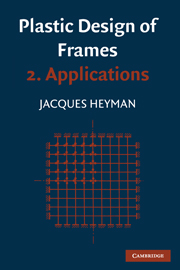5 - ELASTIC–PLASTIC ANALYSIS
Published online by Cambridge University Press: 05 November 2011
Summary
Simple plastic theory is concerned with the collapse state of structures, and the calculations furnish corresponding values of collapse loads (or load factors), or, alternatively, enable a design to be made to sustain given loads. By its nature the theory gives no information on the deformation of a structure as a whole, or of individual members, beyond the derivation of an ultimate mechanism of collapse. Further, a frame will in general not collapse by a regular mechanism for which the whole structure becomes statically determinate; rather, the typical behaviour is to collapse by a partial mechanism, which leaves a portion at least of the frame still redundant. For the purpose of assessing collapse loads within the assumptions of simple plastic theory, this behaviour is satisfactory; that is, providing it is known (for example) that deflexions are small (in the structural sense of not interfering with the equilibrium equations), and that local and overall stability is assured, then reliance can be placed on the calculated values. The simple theory is, effectively, a rigid–plastic theory, and it is assumed in the first instance that a real structure conforms to that theory.
The designer will wish in practice to make sure that the basic assumptions are satisfied; for example, he will wish to estimate deflexions to ensure that he can indeed apply the simple theory, and to check that overall deformations do not impair any structural function.
Information
- Type
- Chapter
- Information
- Plastic Design of Frames , pp. 88 - 125Publisher: Cambridge University PressPrint publication year: 1971
